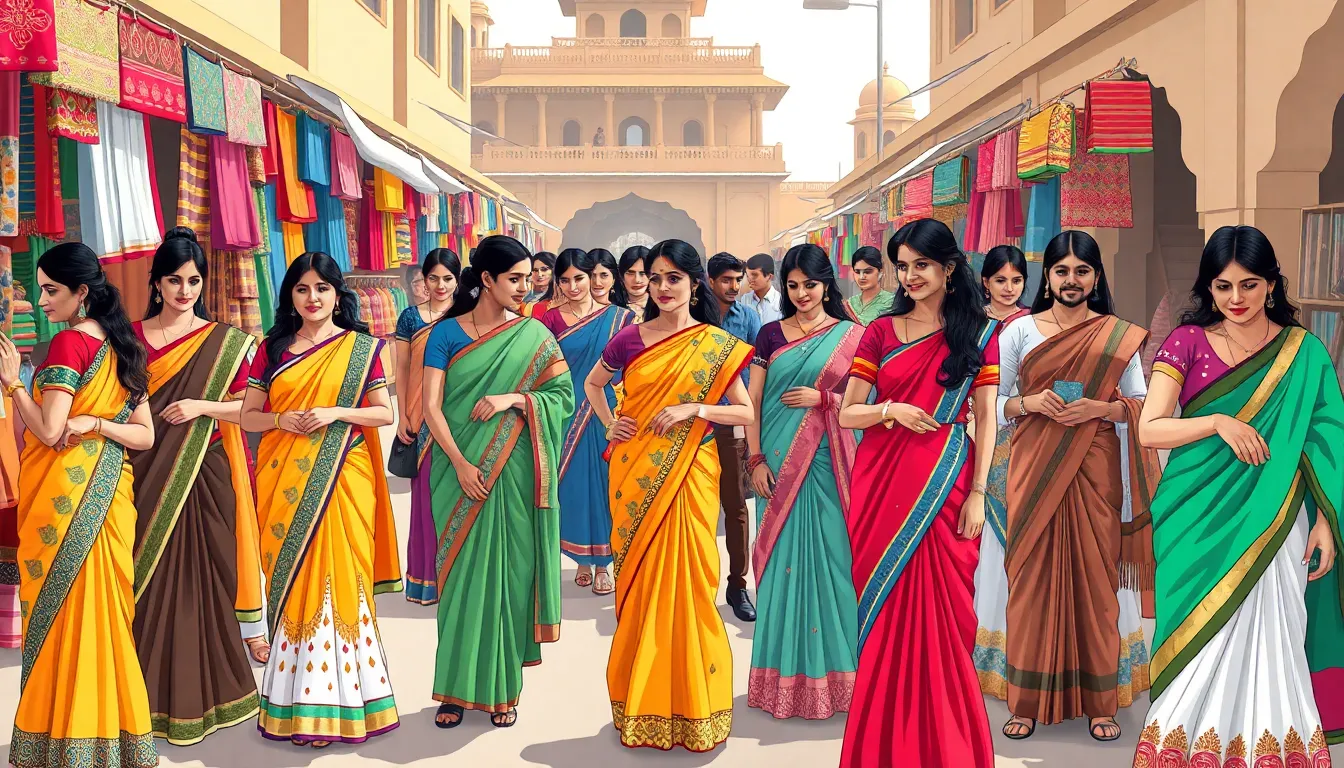Fashion in India is like a vibrant tapestry, weaving together tradition and modernity with a dash of flair. As the seasons change, so do the trends, and 2023 is no exception. From the bustling streets of Mumbai to the chic boutiques of Delhi, style enthusiasts are embracing bold colors, unique silhouettes, and sustainable choices that reflect their individuality.
Table of Contents
ToggleOverview of Latest Fashion Trends in India
Fashion in India continues to evolve, combining tradition with contemporary elements. Bold colors dominate the scene, with shades like tangerine, emerald, and teal leading the way. Unique silhouettes capture attention, featuring asymmetrical cuts and oversized shapes.
Sustainable fashion gains traction as more designers focus on eco-friendly materials. Cotton, linen, and recycled fabrics emerge as popular choices for conscious consumers. Streetwear trends influence urban fashion, with graphic tees and baggy pants making waves in cities like Mumbai and Delhi.
Accessories play a vital role in completing looks. Chunky jewelry and statement bags add flair, often reflecting regional art and craft. Footwear trends include chunky sneakers paired with traditional attire, merging comfort with style.
Cultural motifs flourish, with ethnic prints seeing a resurgence. Designers incorporate traditional embroidery and fabrics into modern pieces, preserving heritage while appealing to younger audiences. The influence of global fashion is apparent, with Indian designers showcasing their collections at international fashion weeks.
Seasonal fashion shows highlight emerging talents and innovative designs. Events focus on various themes, from minimalism to maximalism, celebrating the diversity of Indian aesthetics. Overall, the latest trends reflect a vibrant tapestry of influences, ensuring fashion in India remains dynamic and exciting.
Traditional Influences on Current Fashion

Traditional influences play a significant role in shaping contemporary fashion trends in India. Various styles merge cultural heritage with modern aesthetics, creating unique offerings.
Fusion Wear
Fusion wear signifies the blend of traditional Indian garments with Western styles. Designers often combine sarees with denim jackets or team lehengas with crop tops. This approach caters to the evolving preferences of fashion enthusiasts who value versatility. Mixing fabrics like silk with cotton delivers comfort while preserving elegance. Accessories, such as juttis paired with Western outfits, accentuate the eclectic vibe. Using bold prints alongside minimalist silhouettes captures attention. The influence of diverse cultures further enriches this trend, enabling creative freedom.
Ethnic Wear Revivals
Ethnic wear revivals highlight a renewed appreciation for traditional Indian attire. Designers bring classic silhouettes back into the spotlight, showcasing intricate craftsmanship and regional artistry. Styles such as Anarkalis and floor-length gowns are gaining popularity at festive occasions and celebrations. Vibrant colors and rich fabrics evoke nostalgia, while modern cuts offer contemporary touches. Additionally, sustainable practices are embraced through the use of heritage textiles. Contemporary motifs and embellishments create a striking balance between the past and present. Ethnic wear continues to evolve, appealing to a broader audience seeking authenticity.
Contemporary Styles Gaining Popularity
Fashion trends in India continually evolve, showcasing vibrant styles that reflect both tradition and modernity. The latest shifts emphasize street style and sustainable movements, capturing the attention of fashion-forward individuals.
Street Style Trends
Street style reflects urban culture, showcasing individuality through unique combinations. Graphic tees paired with oversized denim jackets remain popular, allowing for relaxed yet expressive looks. Baggy pants appear frequently, providing comfort and a sense of casual chic. Accessories such as bucket hats and colorful crossbody bags add playful elements. Footwear selections often include chunky sneakers, seamlessly blending comfort and style. Regional influences contribute to graphic designs, making each outfit personal. Fashion enthusiasts frequently mix high and low-end pieces, further amplifying their originality.
Sustainable Fashion Movements
Sustainable fashion movements emphasize eco-friendly practices and materials. Designers prioritize organic fabrics like linen and cotton, reflecting a commitment to the environment. In addition, recycled materials gain traction in collections, highlighting innovation. Slow fashion principles focus on quality over quantity, encouraging mindful purchasing habits among consumers. Local artisans play a vital role by using heritage textiles in contemporary designs, bridging past and present. This focus on sustainability fosters a deeper appreciation for craftsmanship, ensuring authenticity in each piece. Eco-conscious brands resonate with a growing demographic seeking styles that align with their values.
Impact of Social Media on Fashion Choices
Social media plays a crucial role in shaping fashion preferences in India. Platforms like Instagram and TikTok influence trends, making them accessible to a wider audience. Designers and brands leverage these platforms to showcase their collections, reaching millions in an instant.
Fashion influencers drive significant attention, often setting the standard for upcoming styles. Their ability to curate outfits and share personal experiences fosters a strong sense of community among followers. Users frequently engage with these influencers, leading to viral trends that blend traditional and contemporary styles.
Engagement through likes and shares accelerates the popularity of certain trends. For instance, bold colors such as tangerine and teal gain traction as influencers wear them in various creative ways. Asymmetrical cuts and oversized silhouettes are commonly featured in influencer posts, further solidifying their presence in urban fashion.
Social media also highlights sustainable fashion choices. Many influencers advocate for eco-friendly materials, inspiring followers to embrace brands that prioritize sustainability. Organic fabrics, recycled materials, and artisans’ craftsmanship receive significant attention, appealing to an audience that values authenticity and ethical consumption.
The constant flux of trends encourages rapid adaptability. Fashion weeks and seasonal shows trend through live coverage, allowing viewers to witness creativity in real-time. Emerging designers gain recognition through social media exposure, elevating diverse Indian aesthetics on a global scale.
Together, these elements demonstrate the profound impact of social media on fashion decisions in India. This digital landscape fosters connections between consumers and creators, shaping modern fashion narratives while respecting traditional roots.
Fashion Events and Showcases in India
Fashion events in India play a vital role in highlighting the latest trends and celebrating local talent. Major cities like Mumbai and Delhi host numerous fashion weeks and showcases throughout the year, providing platforms for both established and emerging designers. India Fashion Week, Lakme Fashion Week, and Couture Week attract significant media attention and feature collections that blend contemporary styles with traditional craftsmanship.
Runway shows offer audiences a glimpse of upcoming trends, showcasing bold colors like tangerine, emerald, and teal, as well as innovative silhouettes. Designers frequently incorporate sustainable practices in their collections, emphasizing eco-friendly materials such as organic cotton and recycled fabrics. This movement reflects the growing demand for sustainable fashion among consumers who prioritize ethical choices.
Fashion exhibitions also contribute to the vibrancy of the industry, allowing artisans to display their work and promote heritage textiles. Events focused on regional styles enable designers to highlight unique motifs and techniques that celebrate India’s diverse craftsmanship. Collaborations between designers and artisans foster a deeper connection between contemporary fashion and traditional art forms.
Emerging designers gain visibility through events, leading to collaborations that further elevate Indian fashion. Social media plays a critical role in promoting these events, facilitating broader audience engagement and allowing fashion enthusiasts to follow their favorite designers. Influencers’ participation significantly impacts trend visibility, generating discussions around styles that resonate with younger demographics.
Participation in international fashion weeks has increased, showcasing Indian designers on a global stage. Their work often combines regional influences with modern aesthetics, capturing the essence of Indian culture while appealing to global fashion markets. This exchange strengthens India’s position in the global fashion landscape and reinforces the importance of cultural storytelling through fashion.
Fashion in India continues to evolve, reflecting a vibrant blend of tradition and modernity. The latest trends showcase bold colors and unique silhouettes, emphasizing individuality and self-expression. Sustainable practices are becoming increasingly important, with designers embracing eco-friendly materials and promoting slow fashion principles.
As urban areas like Mumbai and Delhi lead the charge in contemporary style, the influence of social media cannot be overlooked. Platforms like Instagram and TikTok play a crucial role in shaping trends, making fashion more accessible to diverse audiences.
With a renewed appreciation for traditional craftsmanship and the rise of fusion wear, India’s fashion landscape remains dynamic and exciting. The ongoing celebration of cultural aesthetics ensures that fashion in India will continue to inspire and captivate both locally and globally.



